
|   |

|   |
Picture perfect dancing - Shveta Arora e-mail: shwetananoop@gmail.com Photos: Anoop Arora May 29, 2014 A photograph can immortalise a perfect moment, capturing all its nuances. The second edition of the annual event Spandan, a world photography exhibition at India Habitat Centre, culminated on the 5th of May, with an evening of dance performances by upcoming dancers. Spandan had large format photographs displayed at the IHC grounds. Spandan has been conceived, curated and executed by R Sreenivasan, a dance photographer himself. It included the works of 30 photographers from different countries. The focus was on the work of Avinash Pasricha, who has been doing dance photography for the past 30 years. 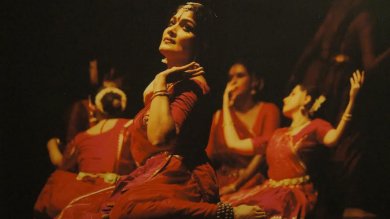
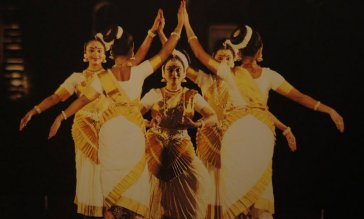
Photo exhibits at
Spandan
The first performance for the evening was a Kathak solo by
Astha Dikshit. A disciple of Malti Shyam and Harish
Gangani, she has been dancing to Sufi poetry. For the
first piece, she danced to poetry by Khwaja Ghulam Farid.
The composition was in raag Jhanjhoti in teen taal. The
poet describes the beauty of the creator and his presence
in all the diversity of life - tenu badal, barkha,
gaach aakhan, tenu geet granth ved gyaan agyaan aakhan,
pothi quran, mandir, masjid aakhan (should I call
you the cloud or rain, song or the book, knowledge or
ignorance, book of Hindus or the Quran, temple or mosque).
The abhinaya had a lot of grace. Astha’s white costume
added to the serenity of the piece. She danced to a piece
by Bulle Shah next – ‘tere ishq nachaya karke thaiya
thaiya' (your love made me dance). The music for the
piece was melodious. Astha concluded with dervish style
dancing to ‘mein tere qurbaan, tere jaya mainu hor na
koi’ (there is no other like you). It was a divine
experience to see her pirouetting.The next dancer was Anwesha Mahanta, an exponent of Sattriya dance of the Vaishnavite stream. She is empanelled with the ICCR and an A-grade artist of Doordarshan. Her first piece for the performance was an ode to Guru Sankaradeva and Bharat Bhumi. Dhanya dhanya bharat varshe was in raag Bhatiyali in teen taal. The next piece was an obeisance to Lord Krishna. The poem sung the beauty of Krishna with the peacock feather, the savior of people from the serpent Kalia and the one who danced on its hood after vanquishing it. Anwesha showed a lot of energy in her footwork and leaps. 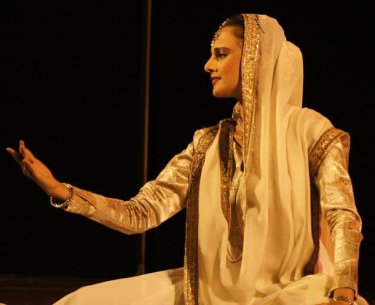 Astha Dikshit 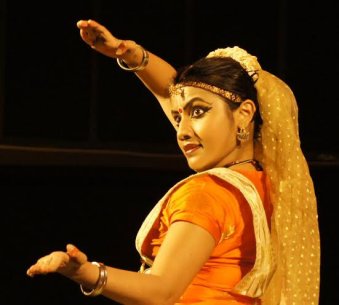 Anwesha Mahanta 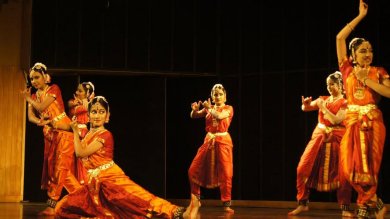 Natya Vriksha 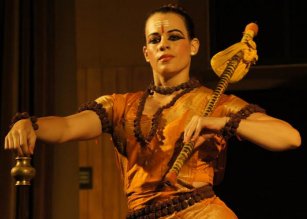 Carolina Prada Next to take the stage were the students of Natya Vriksha, a group of promising young and some very young dancers. Disciples of Geeta Chandran, they reflected to quite an extent the perfection of their guru. The first piece they did was a composition by Bhakta Surdas in raag Mallika, adi talam. The poetry delved into the beauty of Lord Krishna as he roamed with his brother Balaram. Sunder Shyam sunder varleela, sunder bolat vachan rasaal, murli madhur bajavat, Gopal jodi ati bhavati (Krishna is as beautiful as are his antics and his words. He plays the flute while herding his cows and the pair of Krishna and Balaram is a sight to behold). The dancers depicted their beautiful cheeks, feet, ear ornaments and vanmala. In the end, the last frame of gopis admiring Krishna was perfectly executed. Next they presented a tillana in raag Vrindavani, adi talam. The synchronised footwork and technique of nritta was commendable. Carolina Prada is a disciple of Janmejoy Saibabu. The solo in martial art form Mayurbhanj Chhau had leaps, balancing stances, leg stretches and was very athletic. The following performances were contemporary or cross cultural dance by Delhi Dance Theatre titled ‘Inclined together.’ It was a blend of ballet and contemporary movements. This was followed by popping by Furkhan, a dance form which I do not know much about. But still it was interesting for its unique body movements 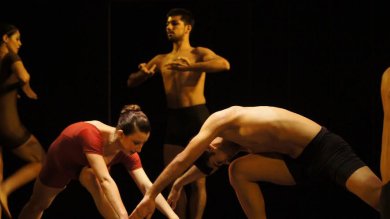 Delhi Dance Theatre  Banjara School of Dance The last to perform were the belly dancers from Banjara School of Dance. Their colourful costumes and pelvic movements, with an attitude to match, mesmerized the audience. The event provided a platform that was shared and admired by both the contemporary and classical dance forms. Shveta Arora is a blogger based in Delhi. She writes about cultural events in the capital. |